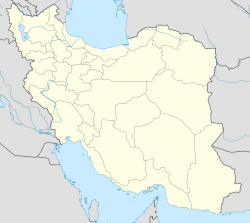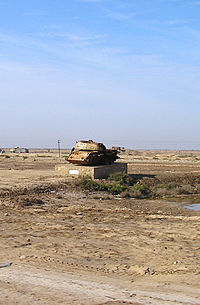
Abadan, Iran
Did you know...
SOS Children, which runs nearly 200 sos schools in the developing world, organised this selection. Visit the SOS Children website at http://www.soschildren.org/
| Abadan آبادان |
|
|---|---|
| — city — | |
|
|
|
| Coordinates: 30°20′21″N 48°18′15″E Coordinates: 30°20′21″N 48°18′15″E | |
| Country | |
| Province | Khuzestan |
| County | Abadan |
| Bakhsh | Central |
| Population (2006) | |
| • Total | 217,988 |
| Time zone | IRST ( UTC+3:30) |
| • Summer ( DST) | IRDT ( UTC+4:30) |
Abadan ( Persian: آبادان, also Romanized as Ābādān) is a city in and the capital of Abadan County, Khuzestan Province, Iran. It lies on Abadan Island (68 km or 42 mi long, 3–19 km or 2–12 miles wide, the island is bounded in the west by the Arvand waterway and to the east by the Bahmanshir outlet of the Karun River), 53 kilometres (33 mi) from the Persian Gulf, near the Iraqi-Iran border. The civilian population of the city dropped to near zero during the eight-years Iran–Iraq War. In 1992, only 84,774 had returned to live in the city. By 2001, the population had jumped to 206,073, and it was 217,988, in 48,061 families, according to 2006 census. Abadan Refinery is one of the largest in the world.
Etymology
The earliest mention of the island of Abadan, if not the port itself is found in works of the geographer Marcian, who renders the name "Apphadana". Earlier, the classical geographer, Ptolemy notes "Apphana" as an island off the mouth of the Tigris (which is, where the modern Island of Abadan is located). An etymology for this name is presented by 'B. Farahvashi to be derived from the Persian word "ab" (water) and the root "pā" (guard, watch) thus "coastguard station").
In the Islamic times, a pseudo-etymology was produced by the historian Ahmad ibn Yahya al-Baladhuri (d.892) quoting a folk story that the town was presumably founded by one "Abbad bin Hosayn" from the Arabian Tribe of Banu Tamim, who established a garrison there during the governorship of Hajjaj in the Ummayad period.
In the subsequent centuries, the Persian version of the name had begun to come into general use before it was adopted by official decree in 1935.
History
Abadan is thought to have been further developed into a major port city under the Abbasids' rule. In this time period, it was a commercial source of salt and woven mats. The siltation of the river delta forced the town further away from water; In the 14th century, however, Ibn Battutah described Abadan just as a small port in a flat salty plain. Politically, Abadan was often the subject of dispute between the nearby states; in 1847, Persia acquired it, in which state Abadan has remained since. From the 17th century onward, the island of Abadan was part of the lands of the Arab Ka'ab ( Bani Kaab) tribe. One section of this tribe, Mohaysen, had its headquarters at Mohammara(present-day Khorramshahr), until the removal of Shaikh Khaz'al Khan in 1924.
It was not until the 20th century that rich oil fields were discovered in the area. In 1910, the population had been around 400. The Anglo-Persian Oil Company built their first pipeline terminus oil refinery in Abadan, starting in 1909 and completing it in 1913 (see Abadan Refinery). By 1938, it was the largest in the world. To this day it remains a vast facility for refining petroleum. The facilities necessitated an equally vast population: more than 220,000 people in 1956.
Only 9% of managers (of the oil company) were from Khuzestan. The proportion of natives of Tehran, the Caspian, Azarbaijan and Kurdistan rose from 4% of blue collar workers to 22% of white collar workers to 45% of managers. Thus while Farsi speakers were concentrated on the lower rungs of the work force, managers tended to be brought in from some distance.
During World War II, Abadan was a major logistics centre for Lend-Lease aircraft being sent to the Soviet Union by the United States.
On 19 August 1978—the anniversary of the US backed pro-Shah coup d'état which overthrew the nationalists and popular Iranian prime minister, Dr. Mohammed Mossadegh—the Cinema Rex, a movie theatre in Abadan, Iran, was set ablaze by four Islamic Revolution sympathizers in an attempt to help the cause of Iran's Islamic Revolution. The local Abadan police had taken notice, and became suspicious of Hossein Takbali-zadeh and his accomplices, and had started following the arsonists as they were entering Cinema Rex. The police decided to continue their surveillance and track the group after they left the movie theatre. This incident ended up led to the Cinema Rex Fire, where over 350 people perished. At the trial, Hossein Takbali-zadeh stated that his three accomplices by the three names Faraj, Falah, and Yadollah had all burned in the fire. The reformist Sobhe Emrooz newspaper in one of its editorials revealed that the Cinema Rex was burned down by the radical Islamists. The newspaper was shut down immediately after.
In September 1980, Abadan was almost overrun during a surprise attack on Khuzestan by Iraq, marking the beginning of the Iran–Iraq War. For 18 months Abadan was besieged, but never captured, by Iraqi forces. Much of the city, including the oil refinery which was the world's largest refinery with capacity of 680,000 barrels per day, was badly damaged or destroyed by the siege and by bombing. Previous to the war, the city's civilian population was about 300,000, but before it was over, most of the populace had sought refuge elsewhere in Iran.
After the war, the biggest concern was the rebuilding of Abadan's oil refinery. In 1993, the refinery began limited operation & and the port reopened. By 1997, the refinery reached the same rate of production it was at before the war. Recently, Abandan has been the site of major labor activity as workers at the oil refineries in the city have staged walkouts and strikes to protest non-payment of wages and the political situation in the country.
Recent events
To honour the 100th anniversary of the refining of oil in Abadan, city officials are planning an "oil museum." The Abadan oil refinery was featured on the reverse side of Iran's 100-rial banknotes printed in 1965 and from 1971 to 1973.
Places of interest
The Abadan Institute of Technology was established in Abadan in 1939. The school specialized in engineering and petroleum chemistry, and was designed to train staff for the refinery in town. The school's name has since changed several times, but since 1989 has been considered a branch campus of the Petroleum University of Technology, centered in Tehran.
There is an international airport in Abadan. It is represented by the IATA airport code ABD.
Notable residents
- Abie Nathan (1927–2008), Israeli humanitarian and peace activist
Climate
The climate in Abadan is arid and similar to Baghdad's, but slightly hotter due to Abadan's lower latitude. Summers are dry and hot, with temperatures above 45 degrees almost daily with a mean of around 55 degrees, soaring temperatures may advance to over 65 degrees. Winters are mildly wet and spring-like, though subject to cold spells. Winter temperatures are around 16–20 degrees. The world's highest unconfirmed temperature was a temperature flare up during a heat burst in June 1967, with a temperature of 87 °C (189 °F).
| Climate data for Abadan | |||||||||||||
|---|---|---|---|---|---|---|---|---|---|---|---|---|---|
| Month | Jan | Feb | Mar | Apr | May | Jun | Jul | Aug | Sep | Oct | Nov | Dec | Year |
| Record high °C (°F) | 25 (77) |
28 (82) |
34 (93) |
43 (109) |
47 (117) |
48 (118) |
50 (122) |
51 (124) |
48 (118) |
43 (109) |
36 (97) |
29 (84) |
51 (124) |
| Average high °C (°F) | 17 (63) |
20 (68) |
24 (75) |
31 (88) |
38 (100) |
42 (108) |
44 (111) |
45 (113) |
42 (108) |
36 (97) |
27 (81) |
20 (68) |
32 (90) |
| Average low °C (°F) | 7 (45) |
9 (48) |
13 (55) |
18 (64) |
23 (73) |
26 (79) |
28 (82) |
27 (81) |
23 (73) |
18 (64) |
14 (57) |
9 (48) |
18 (64) |
| Record low °C (°F) | −3 (27) |
−3 (27) |
2 (36) |
7 (45) |
16 (61) |
19 (66) |
23 (73) |
22 (72) |
16 (61) |
12 (54) |
1 (34) |
−4 (25) |
−4 (25) |
| Precipitation mm (inches) | 38 (1.5) |
43 (1.69) |
15 (0.59) |
20 (0.79) |
3 (0.12) |
0 (0) |
0 (0) |
0 (0) |
0 (0) |
3 (0.12) |
25 (0.98) |
46 (1.81) |
193 (7.6) |
| Source: BBC Weather | |||||||||||||



